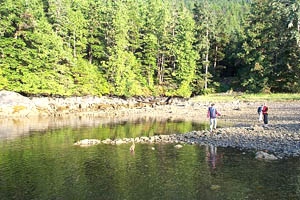| |
|
| Charles R. Menzies |
| Courses |
| Publications and Presentations |
| Research |
| Student Projects |
| Ethnographic Film Unit |
Research: North CoastTsimshian traditional fishing gear and techniques
Part of the explanation of salmon stock collapses in the twentieth century resides in the different methodologies of the indigenous and industrial fisheries. As Taylor comments “aboriginal and industrial harvests appear statistically similar, but the fishery had changed radically. Indians had harvested various runs and species from March to November, but Euro-American consumers preferred the deep orange meat of chinook[spring] and sockeye. Canners quickly learned to concentrate on the runs of favoured species between April and July” (1999:63). While our research substantiates Taylor’s contention that “what distinguished the two fisheries was their raison d’être” (1999:64), our results directly contradict his unsubstantiated claim that “aboriginal fishers harvested for local use, and technology, demography, and culture combined to moderate catches” (1999:64). In fact fish and fish products harvested in one area were often traded for benefit across great distances (Menzies 2001; see also, Daly 2005). In addition, as our research has indicated, indigenous fishing technologies were highly effective and afforded the capacity of harvesting vast quantities of fish. The limiting factor was a community’s ability to process fish quickly enough (see Donald 1997). Furthermore, our research reveals that these technologies were regulated by traditional structures of resource management which controlled harvest pressure, and these controls were combined with active habitat management and enhancement. At the beginning of the twenty-first century, the Canadian government is turning towards more active intervention in the regulation of salmon harvests. In light of growing concerns regarding certain species of salmon (particularly coho) and an emphasis on managing to the weakest run in mixed stock fisheries, attention is returning to gear types that were able to harvest fish in the millions without apparent ecological damage (Kew 1989; Newell 1993; Harris 2001). Starting in the late 1990s Canada’s federal Department of Fisheries and Oceans began to explore the use of selective fishing gear such as beach seines, floating and mobile fish traps and fish wheels to improve the salmon fleet’s ability to avoid non-target species. While similar in some ways to indigenous technologies, few of these projects have attempted to employ traditional First Nations gear and technology in any meaningful sense (see Brown 2006, for a discussion of the attempts to deploy traditional indigenous fishing gear in British Columbia). In our research into traditional Tsimshian fishing gear and techniques we have come to the conclusion that a reintroduction of ecologically appropriate traditional fishing gear is one path toward truly sustainable fisheries. We emphasize how these technologies are associated with particular forms of resource management that limit and disperse harvest pressure. This is accomplished by documenting the linkage between traditional fishing gear, local ecological knowledge and contemporary conservation potentials. In developing this argument we draw upon research conducted in collaboration with fishers and Elders from the Gitxaała First Nation and in particular, their concept of syt güülm goot: “being of one heart”. This concept underpins Gitxaała approaches to resources and how they should be used and shared. It premised upon a community-based conception of resource use in which people and non-humans share important reciprocal relationships of trust, respect, and –when things go wrong- retribution (we will return to this concept below in our discussion of community-based use and conservation principles). |
|
| Last reviewed 23-Sep-2006 to top | UBC.ca » Charles R. Menzies Charles R. Menzies, Ph.D. Associate Professor of Anthropology Department of Anthropology University of British Columbia 6303 NW Marine Drive Vancouver, BC. V6T 1Z1 tel 604-822-2240 | fax 604-822-6161 | e-mail cmenzies@interchange.ubc.ca © Copyright The University of British Columbia, all rights reserved. |
 The
historical abundance of salmon along the west coast of North America
has been significantly reduced during the last two centuries of
industrial harvest. Commercial fisheries from California to Alaska
and points in between have faced clearly documented restrictions
on fishing effort and collapse of specific salmon runs. Even while
salmon runs on some large river systems remain (i.e., the Fraser
and Skeena Rivers), many smaller runs have all but disappeared.
The life histories of many twentieth century fisheries have been
depressingly similar: initial co-existence with indigenous fisheries;
emergence of large-scale industrial expansion followed by resource
collapse; introduction of limited restrictions on fishing effort
which become increasingly severe, making it hard for fishing communities
to survive and to reproduce themselves. Yet, for nearly two millennia
prior to the industrial extraction of salmon indigenous peoples
maintained active harvests of salmon which are estimated to be
at or near median industrial harvests during the twentieth century.
The
historical abundance of salmon along the west coast of North America
has been significantly reduced during the last two centuries of
industrial harvest. Commercial fisheries from California to Alaska
and points in between have faced clearly documented restrictions
on fishing effort and collapse of specific salmon runs. Even while
salmon runs on some large river systems remain (i.e., the Fraser
and Skeena Rivers), many smaller runs have all but disappeared.
The life histories of many twentieth century fisheries have been
depressingly similar: initial co-existence with indigenous fisheries;
emergence of large-scale industrial expansion followed by resource
collapse; introduction of limited restrictions on fishing effort
which become increasingly severe, making it hard for fishing communities
to survive and to reproduce themselves. Yet, for nearly two millennia
prior to the industrial extraction of salmon indigenous peoples
maintained active harvests of salmon which are estimated to be
at or near median industrial harvests during the twentieth century.